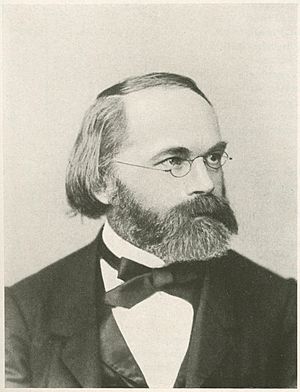Carl Nägeli facts for kids
Quick facts for kids
Carl Wilhelm von Nägeli
|
|
|---|---|
 |
|
| Born | 26 or 27 March 1817 |
| Died | 10 May 1891 (aged 74) |
| Nationality | Swiss |
| Known for | research on plant anatomy |
| Scientific career | |
| Fields | Botanist |
| Influenced | Georg Baur |
Carl Wilhelm von Nägeli (born March 26 or 27, 1817 – died May 10, 1891) was a Swiss scientist. He was a botanist, which means he studied plants. He looked closely at how plant cells divide and how pollination works.
Nägeli is also known for his discussions with Gregor Mendel. Mendel was famous for his work on genetics, which is the study of how traits are passed down. Nägeli didn't agree with Mendel's ideas at first. He also had his own theories about how living things change over time, called evolution. He believed in something called "orthogenesis," which suggested an "inner perfecting principle" guided evolution.
Contents
Early Life and Education
Carl Wilhelm von Nägeli was born in Kilchberg, a town near Zürich in Switzerland. He first studied medicine at the University of Zürich.
In 1839, he decided to focus on botany. He studied plants at the University of Geneva. He earned his degree in botany from Zürich in 1840. A professor named Matthias Jakob Schleiden encouraged him to study plants using a microscope. This led Nägeli to focus on tiny details of plants. In 1858, he even created the term "meristematic tissue." This is a special type of plant tissue where growth happens.
Becoming a Professor
After finishing his studies, Nägeli became a private teacher at the University of Zürich. Soon after, he became a professor there. Later, he moved to the University of Freiburg to teach botany. In 1857, he became a professor at the University of Munich. He stayed there as a professor until he passed away.
Important Discoveries and Ideas
Nägeli made several important contributions to science.
Observing Cell Division
In 1842, it was believed that Nägeli was the first to see cell division happening. He observed this process when pollen was forming. However, some scientists later questioned if he fully understood what he saw. They debated whether he realized how important the nucleus is in a cell's life.
Discovering Microsporidia
In 1857, Nägeli was the first to describe tiny organisms called microsporidia. These tiny creatures cause a disease called pebrine in silkworms. This disease caused big problems for the silk industry in Europe a long time ago.
Working with Gregor Mendel
Nägeli is perhaps best known for his letters with Gregor Mendel. Mendel had done important experiments with garden peas. He figured out how traits are passed from parent plants to their offspring. This work laid the foundation for modern genetics.
Nägeli and Mendel wrote to each other between 1866 and 1873. However, Nägeli didn't seem to fully understand or appreciate Mendel's discoveries. At the time, Nägeli was working on his own big book about how living things evolve. In this book, he talked about something he called "idioplasm." He thought this "idioplasm" was what carried inherited traits.
Interestingly, when Nägeli's book was published in 1884, it didn't mention Mendel's work at all. Many people find this surprising, especially since Nägeli was thinking a lot about how traits are passed down.
Understanding Plant Parts
Nägeli and another scientist, Hugo von Mohl, were the first to tell the difference between a plant's cell wall and its inner parts. They named the inner parts "protoplasm" in 1846. Nägeli believed that cells got their inherited traits from a part of the protoplasm, which he called the "idioplasma."
Nägeli also created other important terms in botany in 1858. These include 'Meristem' (the growing parts of plants), 'Xylem' (which carries water in plants), and 'Phloem' (which carries food in plants).
Ideas on Evolution
Nägeli was a supporter of orthogenesis. This idea suggests that evolution is guided by an internal force or "inner perfecting principle." He believed that many changes in evolution were not just about adapting to the environment. Instead, he thought these changes were programmed from within the organism. This view was different from Darwinism, which focuses on natural selection.
See also
 In Spanish: Karl Wilhelm von Nägeli para niños
In Spanish: Karl Wilhelm von Nägeli para niños
- University of Freiburg Faculty of Biology

